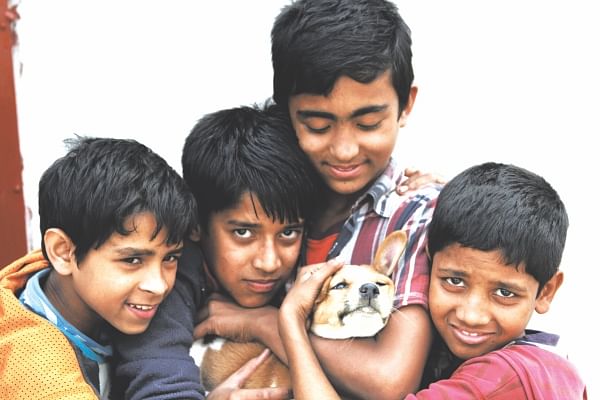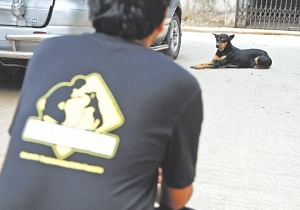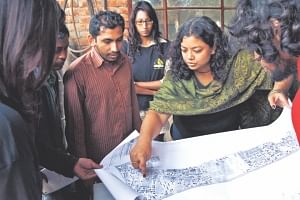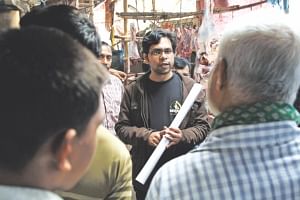| Home - Back Issues - The Team - Contact Us |
 |
| Volume 11 |Issue 04| January 27, 2012 | |
|
|
Special Feature
The Volunteer Squad Soraya Auer Nervously watching from where they sat, Sohail, Munna, Russel and Hridoy spoke between themselves in hushed voices. Earlier that morning, the young boys had not expected to run after a team of animal control officers on a truck, shouting at them to stop. “Years ago, the DCC (Dhaka City Corporation) picked up and killed two of our dogs, Shomrat and Tiger,” says Russel. Worried this was about to happen again, the four boys protested to their dogs being taken away and insisted on staying with them to ensure their safety. The boys climbed into the back of the truck and found themselves taken to Obhoyaronno Spray Neuter Clinic near Bosila Bridge, Mohammadpur – Bangladesh's only animal welfare organisation's first field clinic. “We thought they would take the dogs and export them abroad,” admits the smallest Munna. Obhoyaronno is the first organisation of its kind and has been campaigning since its creation in 2009 against the same dog culling practice these young boys were afraid of. As of this month, January 2012, their campaign in the capital has come to an end as the DCC has agreed to stop dog culling. It was a practice used (and still used by the rest of Bangladesh) to tackle dog overpopulation, rabies and public nuisance. Obhoyaronno launched its community welfare and dog population management programme this month in a bid to offer a humane and more effective way of dealing with these problems.
“We have a team of trained dog catchers who humanely catch the dogs on the streets and bring them to our clinic for vaccination and surgery,” says Dr Nawroj Mehdi, one of four veterinary surgeons at the field clinic. “We vaccinate the dogs against rabies and spray or neuter them as part of the programme to control the dog population. We've been trained by HSI (Humane Society International) to perform sterile and modern surgeries. And by the afternoon, the dogs are returned to exactly where they were found.” Obhoyaronno is a young organisation, still learning to walk on its four paws, with limited resources and manpower, in a country that is still developing into a modern self-sustaining economy. “People say Bangladeshis are too poor to care about animals,” says Rubaiya Ahmad, founder and chairperson of Obhoyaronno. “But when you see the beggar or shop keeper share what little daal and bhaat they have with a community owned dog, you realise people have distorted perception as to how the poorer communities feel about dogs. “When we were out in the field, most people said they hated the way dogs were being killed. And when we did the dog population survey, we saw that 80% of dogs are owned by either individuals or a community. So the seemingly stray dogs are someone's pet,” explains Rubaiya. Obhoyaronno's clinic employs four vets, four paravets and three animal control officers. Everyone else, including Rubaiya, works for Obhoyaronno for free and out of a love for animals. The volunteers that are crucial to the organisation's continuing success are like a 'volunteer squad', working hard for the welfare of free-roaming dogs. “There is so much work that needs to happen before the dog is up on the surgical table,” says Rubaiya. “We are trying to run a free clinic because that is the only way we can give the services people and animals need. To do that, we have to rely on public donations and volunteers. All the prep work that is done before surgery is done by volunteers. They walk the streets to survey the dog population, raise awareness in the communities and inform people about what we're doing and when our animal control officers will be in their area.”
She adds, “It's not glamorous, and there is a lot of administrative work and leg work that needs to be done, like in any other office. We always have something for people to do and time is money, so as far as I'm concerned, any hour of the day someone can give, counts.” At present there are twenty volunteers in different capacities. Some are students and work short term while others are have full-time jobs and have committed to working from home on long term research and document-drafting projects. “Anybody who can commit time or has interest is welcome,” Rubaiya says. Twenty-two-year-old volunteer Rishad Habib has been following Obhoyaronno's progress for more than a year. She says, “The people who say there should be human rights before animal rights are the ones that don't do anything at all for either. There are so many organisations supporting human causes in Bangladesh. Animals don't have anyone to speak up for them, which is why I like what Obhoyaronno is doing.” She also says, “Volunteering isn't supposed to be glamorous but there's a bit of a trend now in Bangladesh. Social causes are the new thing to get involved in. Jaago (a Bangladeshi foundation working to alleviate poverty through access to education) had 7,000 volunteers at their last event so it's kind of like the 'in' thing. But Obhoyaronno is such a small team that if anyone doesn't show up, it'll affect how fast the work will get done, so it's important to get more volunteers committed to the cause.” One such volunteer committed to the cause is Farista Mahbub, a 19-year-old business student. She believes volunteering for an animal welfare organisation is different. “I've volunteered for Jaago too but I think most people's motivation there was to get the certificate. For Obhoyaronno, we actually have to go out and talk to people who don't even know what animal welfare is, and explain to them why it's important.” Last week, three kids from a Mohammadpur slum brought a small deshi puppy with a broken leg to the clinic. The boys didn't know how the leg had been broken or whose puppy it was, but they remembered the safe place volunteers had told them about only days before. “It wasn't moving around and just stayed still like a stuffed toy,” says Farista, who owns a dog and a cat. “After the vet treated her, I couldn't just send her straight back to the street as tiny and weak as she was – what if she couldn't survive? I've been looking after her temporarily in my flat for a few days now and she's healthier and chasing my pets around as if she's the boss!” “I'm really glad Obhoyaronno is here,” says amateur photographer, Rahat Alam. “I personally saw dog culling and I hated like it. It's very important to me to be involved because this is the first organisation of its kind in my country and I want it to succeed.” The 20-year-old, who strongly recommends the adoption of local breeds as opposed to importing pedigrees, adds, “The work isn't hard, counting dogs is fun. And the organisation's work is ongoing so I hope to keep returning when I'm on my breaks from university.” Wasif A Khoda, a Dhaka University student, is still passionate about animal welfare despite being pick-pocketed on his first day as a volunteer. “The community was so supportive of me and angry that I had been robbed from in their neighbourhood, considering the work we were trying to do for their dogs. I got back my wallet and half the money. What I didn't realise was how good a people they are. I wouldn't be put off from working with them or in a slum again. This incident has just taught me to put my wallet in a safer place!” He also adds, “I'm planning to bring Obhoyaronno to my university, like through a club, because there are so many young people who could speak publicly about the project and spread the word.” While students are a driving force of the organisation, there are also skilled professionals lending their abilities to the cause. Shoaib Jasim Uddin is an architect, who, in between working for two firms, is designing a more permanent but portable clinic for Obhoyaronno. “I'm trying to keep costs down to a minimum and create a fully functioning clinic that can be disassembled and used again in a different location.” Shoaib admits, “It will be tough and I'm not sure what problems will come up but I will do my best. I'm not doing this to further my career or add to my portfolio. It's not going to be flashy – it's going to hopefully help and serve its purpose to the animals of Dhaka.” With continuing success and support from volunteers, Obhoyaronno's dog population management programme and future field clinics, like the one in Mohammadpur, will serve communities across the capital, and eventually the entire country. While young people and street children have thus far shown a lot of love and commitment to the free-roaming dogs of Dhaka, there is hope the word will spread to those older around them. I take particular solace in the fact that the four boys who followed their dogs to the clinic now have the knowledge of vaccinations and animal welfare to share. When asked what they would say to their parents who don't like them petting dogs, Munna said, “I'll tell them that dogs are human too and we shouldn't discriminate.” Well said young man, well said. Obhoyaronno Spray Neuter Clinic is located at 780/24, Bosila Road, near Bosila Bridge, Mohammadpur, Dhaka. The organisation has a very active Facebook page if you would like to voice your support or offer your services as a volunteer. For more information or to donate email– [email protected] Copyright
(R) thedailystar.net 2012 |



